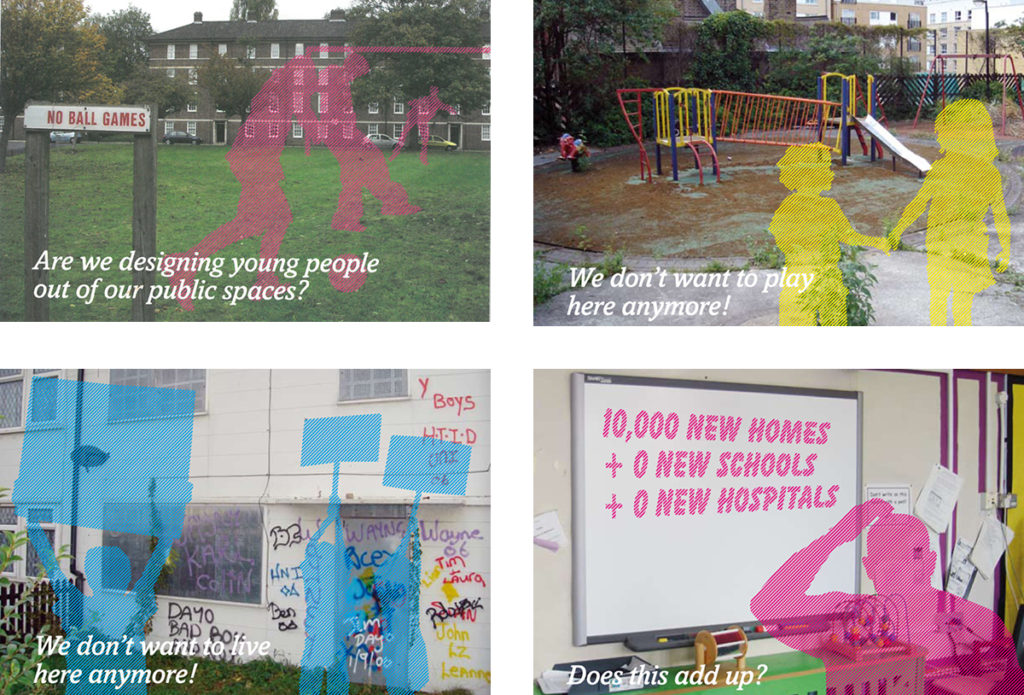Written by:
Back in 2007, The Glass-House produced a series of postcards aimed at stimulating discussion around what we saw as inequities in place. We had come across huge disparity in the quality and the condition of homes and play spaces available to people in different parts of the country, and indeed of any given city. We had seen young people being designed out of public space, and coaxed into corners with the promise of “youth shelters”. We looked at numbers that simply didn’t stack up when it came to housing targets and the infrastructure planned to go alongside these new homes.

As a charity with a mission to make great places a reality for everyone through more engaged and collaborative design, we thought, and still think, that we cannot tackle these disparities if we as a society do not acknowledge and talk about them.
Now, sixteen years and many governments and ministers later, these provocations seem more relevant than ever, with many challenges persisting not just over years, but over decades, and with new issues emerging. The Covid-19 lockdown exposed huge disparity in the quality of homes, access to public and green spaces, functioning high streets and medical facilities. We have all read heart-breaking stories in the last year or two of children’s health and wellbeing being affected by the poor state of their rented homes. Equally shocking is the research on the poor quality of some of the new homes being built. Huge numbers of people don’t seek or get the medical attention they need because there are simply not medical facilities that are geographically within their reach. Research published this summer told us that access to and the condition of play facilities has declined dramatically, particularly in certain parts of the country. Raw sewage is being dumped into our rivers and seas because we do not have adequate infrastructure to treat it as we should. Well over a hundred schools could not open this month for the new academic year because they were deemed unsafe.
My intent is not simply to blame current government structures. While I think political leadership and decision-making can go a long way towards addressing these disparities, it seems clear to me that the political will of any single government, minister, chief executive or elected member is nothing if not part of a wider and sustained movement advocating and investing in change.
This is about the need for systemic change, not party politics.
Both before and since 2007 we have seen countless government initiatives at either end of the political spectrum try to tackle some of these issues. What we have not seen, however, is a sustained, shared commitment and vision for how place quality and place equity can be addressed over time, regardless of who is leading the government at any particular moment. Instead we have seen initiatives and funding come and go in cycles that seem to learn little from those that have gone before them, and do even less to ensure continuity of progress in any given area of focus.
In today’s socio-economic landscape, no single government, be it national or local, no developer, no housing provider or community can drive place quality and improve place equity without a shared commitment and shared investment that crosses political and geographical boundaries and above all political and funding cycles.
I’m not suggesting that we will ever all agree on what will solve these challenges. However, I do believe that we could do a great deal more through a more collaborative, experimental and reflective approach to shaping and improving our built environment and to protecting and revaluing our natural environment.
So what can we do?
1. A cross-party approach to place quality and place equity
What if political leaders across the political spectrum (at national, regional and local levels) co-designed and committed to 10 to 20-year plans and budgets to tackle place quality and equity across administrations, with agreed timetables to evaluate, adapt and improve the shared programme together and then to agree a next stage regardless of who was in power?
2. Being more demanding about how our places are shaped
What if we, as a population, put place quality and place equity higher on the agenda, and demanded more of our politicians and the design, development and construction industries? What if we demanded better homes, public spaces, schools, medical facilities not only for our own neighbourhoods, but for everyone’s?
3. Asking what each of can do to help improve place quality and place equity
Most importantly, what if we rolled up our own sleeves and asked what we could each do to help improve place quality and place equity? What would be possible if we pooled our resources and worked more collaboratively, with a spirit of generosity and of empathy underpinning our placemaking?
I’m often accused of being an idealist. Guilty as charged. However, I am also one that looks for practical solutions, and I truly believe that our best hope of improving the quality and equity of our places is to understand and acknowledge our differences, but then find a way to build on our shared values and objectives to work together.
We at The Glass-House are always working with partners to experiment and innovate practical approaches and processes to enable more collaborative design and placemaking, and we are keen to share what we learn and empower others to have a go themselves. Drop us a line at info@theglasshouse.org.uk if you would like to collaborate with us or to share your co-design stories and learning through our networks.
Here are just some of the news items referenced in the blog:
How to spot the effect of mould on children’s health and who is most affected , Independent, 15 November 2022
Our new build nightmares This is Money, 2 Dec 2021
In 2003, the Social Exclusion Unit (SEU) estimated that 1.4 million people each year miss, turn down or choose not to seek healthcare because of transport Select Committee on Health Third Report
England’s playgrounds crumble as council budgets fall, The Guardian, 4 August 2023
People warned to avoid 83 beaches because of raw sewage dumped nearby, Independent, 16 March 2023
‘Unacceptable’: how raw sewage has affected rivers in England and Wales – in maps, The Guardian, 12 September 2023
New Raac schools list of buildings with unsafe concrete, BBC, 19 September 2023

